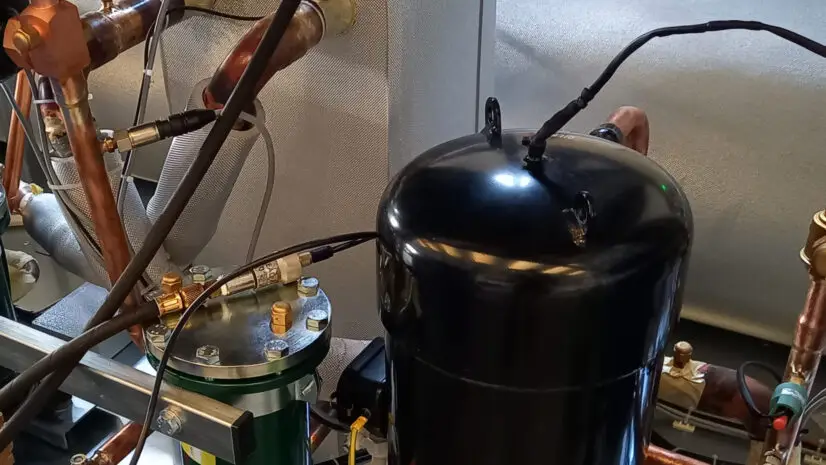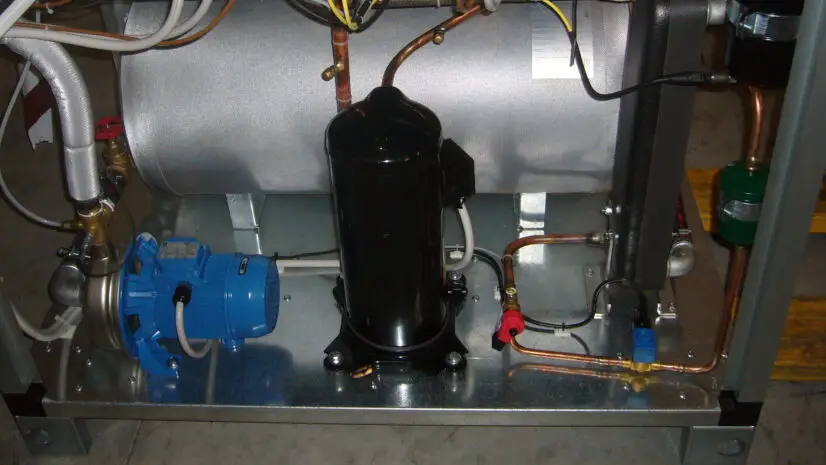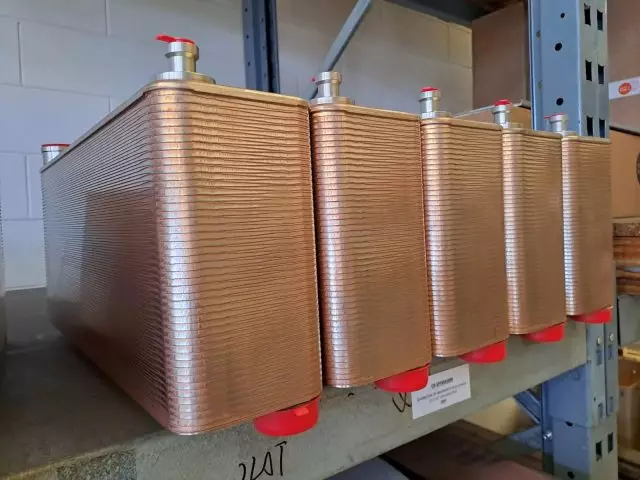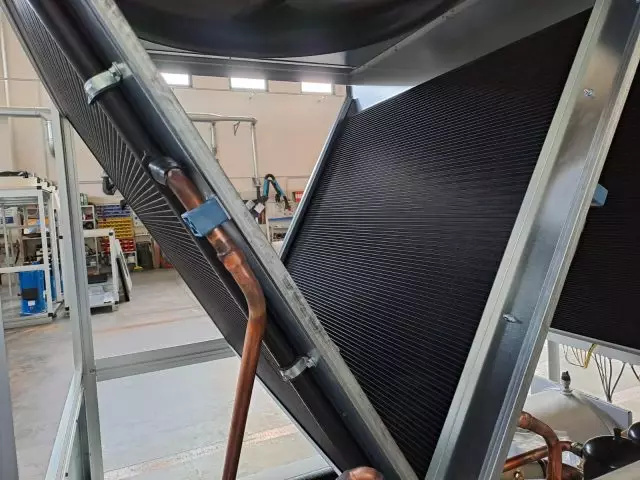Components of an industrial refrigeration circuit and industrial chillers: a complete guide

Are you a professional who needs heat removal from process fluids? Or are you simply curious about how the technology behind maintaining controlled temperatures in industrial processes works? Either way, this guide is perfect for you. In this article, we dive into the inner workings of an industrial refrigeration circuit and industrial chillers in general: we will reveal the essential components that make these systems work.
1. Introduction: industrial chillers and refrigeration circuit
Ensuring precisely controlled temperatures is often crucial for product quality, energy efficiency and plant safety, which is why industrial chillers, complete with appropriate refrigeration circuits, assume a crucial role for a metalworking company’s processes to run smoothly.
An industrial chiller is a cooling system that uses a refrigeration cycle to remove heat from a process or environment and transfer it to the outside. You will often read that the chiller acts as a “reverse heat pump”-in fact, it absorbs heat on one side and releases it on the other.
Unlike other cooling technologies (such as evaporative towers and dry coolers), industrial chillers allow output temperatures to be achieved even below the wet bulb temperature of the installation area: this is due to the so-called mechanical cooling enabled by the refrigeration circuit.
Learn about the components of a chiller and turnkey system2. The main components of an industrial refrigeration circuit
That premise having been made, we can come to our list of components of an industrial refrigeration circuit.
We can first group these main components into four main categories:
- evaporation components (the evaporator),
- compression component (the compressor),
- condensing component (the condenser),
- regulation component (the lamination valve).
And here are in detail the main components of an industrial refrigeration system, accompanied by an appropriate description.
- Evaporator: this is the primary heat exchanger. Here the refrigerant gas absorbs heat from the external environment (in the case of the chiller from the process liquid water and/or water/glycol, other), evaporating it from a liquid to a gaseous state.
- Expansion valve: better referred to as a “lamination valve,” often called a “thermostat”, it is an indispensable device in order for the chiller to function properly. It regulates refrigerant flow according to the heat load, ensuring that the refrigerant itself absorbs all the heat from the process. Through the lamination valve, proper superheating of the refrigerant is ensured.
- Compressor: it is the “engine” of the refrigeration circuit. It increases the pressure of the low-temperature refrigerant leaving the evaporator in a “mechanical” manner through various mechanical systems depending on the type of compressor. This increase in pressure also causes an increase in refrigerant temperature. It is due to the work of the compressor if the operating principle of the chiller is often called “mechanical cooling.”
- Condenser: this is the second heat exchanger in the system. Here, the refrigerant gas (at high pressure and high temperature) releases heat to its surroundings, condensing until it reaches a liquid state again. There are two main types of condensers: air condensers and water condensers. These two types of condensers also divide refrigeration systems into two major families: air-cooled chillers and water-cooled chillers.
Below are some additional key components, thus present in every refrigeration chiller.
- Electric fans: provide controlled air flow through the condenser, aiding heat dissipation and improving system efficiency.
- Storage tanks: also known as puffers, these are storage tanks that contain cold water or glycol. They help stabilize the temperature of water entering the chiller and reduce peak loads, improving system efficiency and lifetime.
- Expansion vessel: is an essential component in systems using a closed loop with glycol water. It accommodates changes in liquid volume due to temperature fluctuations, preventing overpressure within the system.
3. Beyond the main components: additional components of an industrial chiller
Depending on the application and manufacturer, a cooling chiller may include additional components.
- Control and safety tools: an industrial chiller circuit is equipped with various control and safety tools to monitor system operation and prevent failures. These tools may include pressure switches, thermostats, flow switches, and alarm devices.
- Oil separator: in systems with cascade compressors, the oil separator in chillers helps ensure the correct level within the compressors.
- Liquid receiver: this is a tank that stores liquid refrigerant gas, exiting the condenser. It helps stabilize refrigerant flow and provides a reserve of refrigerant for the system since the process chiller needs to be able to operate under different conditions depending on different process environments.
- Filter dehydrator: this component has the function of removing moisture from the refrigerant. Moisture can react with the refrigerant to form corrosive acids, which can damage circuit components.
- Electrical microprocessors: also known as controllers, they manage and control the operation of the chiller. They adjust compressor speed, chilled water supply temperature, and other parameters to optimize system performance.
- Water filter: they remove impurities and sediment from water entering the chiller, protecting internal components from damage and ensuring efficient operation.
- Manual refrigerant charging: allows for manual addition of the refrigerant itself to the circuit in case of leakage or need for refilling.
- Manual water by-pass: has the functionality of diverting water flow from the chiller. This can happen during maintenance or in case of malfunction.
- Subcooling: A term technically associated with the treatment of refrigerant gas inside the chiller. The presence of subcooling of the gas exiting the condenser ensures the complete transformation from the vapor state to the liquid state of the refrigerant, guaranteeing the best achievable performance in terms of cooling capacity.
- Modbus RTU for Industry 4.0: Modbus RTU is one of the communication protocols that allows the chiller to be integrated into industrial automation systems and to monitor and control its operation remotely.
Those we have just seen are, of course, optional components: whether or not to ask the industrial chiller manufacturer to include them in the chiller design depends on several factors. First, different applications require different levels of control, efficiency, and reliability. Also, larger systems may benefit from additional components that improve efficiency and stability.
Last but not least, the budget available for the project: optional components can increase the initial cost of the system, but they can also generate savings in the long run through increased efficiency and reduced operating and maintenance costs of the cooling chiller.
Ask for Information4. Difference between air-cooled and water-cooled condensing chillers
There are two major families into which we can divide compression chillers: namely, air-cooled chillers and water-cooled chillers. Belonging to either type is, of course, a consequence of their internal components.
Let us make it clear at the outset that both perform the same function of expelling heat from the refrigerant. However, the way they do it is different.
- Air-cooled chillers: they use fans to pass air through the condenser, removing heat to the surrounding environment. They are generally easier to install than water-cooled chillers, but can be less efficient in hot climates.
- Water-cooled chiller: these chillers use cold water to absorb heat from the refrigerant in the condenser. The water is then cooled in a separate cooling tower before being recirculated in the condenser. Water-cooled chiller condensers are generally more energy efficient than air-cooled chillers, especially in hot climates, but require additional infrastructure such as a cooling tower.
5. What about spare parts? Factors to consider when choosing parts
Choosing the right components for an industrial refrigeration circuit depends on several factors, including:
- Required cooling capacity: this parameter determines the size and power of the compressor, evaporator, and condenser.
- Type of application: different uses may require specific temperatures and humidity levels, which influences the choice of components.
- Energy efficiency: choosing high-efficiency components can naturally reduce long-term operating costs.
Cost: the initial cost of components must be balanced with the long-term operating and maintenance costs.
6. Maintenance is essential for proper operation

A regular maintenance program is essential to ensure the proper operation and efficiency of an industrial chiller and the refrigeration circuit it employs: preventive maintenance helps prevent breakdowns, extend component life and reduce operating costs.
A valuable ally in this regard are remote management platforms: industrial chiller manufacturers know this and are gearing up to set up their machines for remote monitoring with an “industry 4.0” perspective.
Ask for InformationsResources
Plants and components
Find out all Frigofluid's productsComparing Different Technologies
Find out all the different technologiesFind out more
All technical articlesOur Newsletter
Subscribe to the Frigofluid newsletter: stay up-to-date on technical solutions for industrial refrigeration and cooling and get to know our offer.







